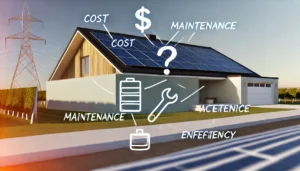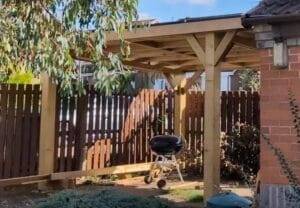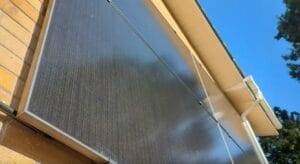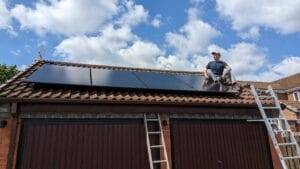When I first considered investing in solar panels, my primary goal was to reduce my home electricity bills. I crunched the numbers, weighed the costs against the potential savings, and decided to take the plunge. Now, 16 months later, I have real-world data on how my system performed—and the results have exceeded my expectations in more ways than one. This is the article I wish I had read before starting my solar journey.
Home Solar Return On Investment And Savings Calculator
Use this calculator to see how much you can save yearly by generating electricity from solar panels. It can help you calculate the ROI (return on investment) of your home solar energy system.
Solar Savings Calculator
The calculator is simplified to maximise the usage of your solar panels generation. In reality to do that you need a battery. For simplicity, the battery section in this calculator is for savings with a flexible tariff.
The model is based on the solar energy generation, export and flexible tariff benefits I experienced in the first 16 months of owning a home solar energy system. Watch this video for more details:
Understanding How the Solar Savings Calculator Works
This solar savings calculator estimates your potential savings from solar panels by considering key factors related to your energy use and solar generation. You start by selecting your estimated annual consumption (using UK averages) or entering your exact usage. We then calculate how much of your consumption can be met with solar power, considering different months of the year, and factor in how much energy would need to be imported from the grid.
Key assumptions baked into this calculator include:
- Seasonal Variation: We distribute both energy consumption and solar generation across the months of the year using average seasonal patterns. Winter months generally have lower solar generation, while summer months have higher production.
- Battery Usage: If you select a battery, we assume that 80% of its capacity is usable. The calculator also considers flexible pricing—charging the battery at night when rates are lower and using it during the day when rates are higher. However, there is a cap: the battery benefit cannot exceed the gap between your solar production and consumption.
- Static Prices: Enter your energy import, export, and night rates. These are assumed to stay constant throughout the year, simplifying the model but may not capture fluctuations in actual market prices.
Limitations to keep in mind:
- Simplified Monthly Distribution: Monthly energy usage and generation are distributed using average percentages. This means the model does not consider daily changes, weather conditions, or unique seasonal fluctuations for your location.
- No Dynamic Price Modeling: We do not account for variations in energy tariffs or future increases/decreases in energy prices, which can impact the accuracy of the projected savings.
- Battery Efficiency: The battery efficiency is estimated, meaning the actual energy stored and used could differ based on specific battery models or environmental factors.
Despite these assumptions, I believe this calculator offers a good approximation of savings because it uses realistic seasonal distributions. I based this on my usage statistics for 16 months. The calculator also incorporates both generation and storage capabilities.
While it won’t capture every nuance of your specific energy situation, it provides a valuable baseline for understanding how solar panels, potentially combined with battery storage, can reduce electricity costs and export benefits. It’s a helpful way to see how solar energy can fit into your home’s energy needs and give you a clearer picture of what to expect.
My Solar Panel System: An Overview
I began by installing a 3.87 kilowatt-peak (kWp) solar panel system on my garage roof, which, due to its pitched design, faces both east and west. This capacity is enough to run common household appliances simultaneously—like your fridge, TV, and even boiling a kettle.
But what does 3.87 kWp mean? In ideal conditions, this is the maximum power the panels can produce. However, perfect conditions are rare, especially in the UK. The highest output I’ve observed is around 3 kilowatts per hour, which is still substantial for home use.
In May 2024, I expanded my system by adding another 3.2 kWp of solar panels, bringing my total capacity to 7 kWp. I’ll delve into this upgrade in a future article, but for now, let’s focus on the initial system and its performance.
The Investment: Breaking Down the Costs
My total investment for the initial system was around £9,000. This figure includes:
- Equipment Costs: Solar panels, inverters, batteries, and mounting hardware.
- Tools: Specialized equipment is needed for installation, some of which are versatile but pricey.
- Professional Services: Hiring certified electricians to handle the grid connection and compliance.
- Registration Fees: Costs associated with registering for energy export with my supplier, Octopus Energy.
It’s worth noting that if you’re considering installing a similar system today in the UK, you’d likely pay less—approximately £1,783 less, to be exact. Component prices have decreased significantly since I purchased in 2023, primarily for solar panels and inverters.
Performance Stats: Energy Generation and Usage
Grid-Tied System Explained
My system is grid-tied, which works in conjunction with the national grid. I still purchase electricity, but the solar panels and batteries significantly supplement my usage.
Electricity Purchased from the Grid
Over the past 16 months, my electricity purchases have fluctuated:
- Summer Months: Lower grid electricity usage due to abundant sunlight.
- Winter Months: Higher grid electricity usage when solar generation is reduced.
If I hadn’t installed the solar panels, my grid electricity usage would have been consistently higher throughout the year.
Solar Energy Utilization
The solar energy generated has been substantial:
- Total Savings on Bills: £858 saved by using solar-generated electricity instead of purchasing from the grid.
- Energy Exported to the Grid: Starting from November 2023, I began exporting surplus energy. I’ve earned £284 so far, receiving 15p per kilowatt-hour exported.
- Battery Charging Savings: By charging my batteries during off-peak hours in the winter and using that energy during peak times, I’ve saved an additional £200.
Unexpected Benefits: Maximizing Savings with Batteries
One pleasant surprise has been the ability to charge my batteries during cheaper nighttime rates and use that stored energy during the day. This strategy has amplified my savings, particularly during the darker winter months when solar generation is lower.
Looking ahead, there’s potential to optimize this further. Switching to an electric vehicle (EV) tariff with even lower nighttime rates could allow me to charge a larger battery bank and cover nearly all my daytime electricity needs, pushing the savings envelope even further.
Total Savings and Return on Investment
Adding up all the savings:
- Solar Energy Usage Savings: £858
- Energy Export Earnings: £284
- Battery Charging Savings: £200
- Total Savings: £1,342
Given these numbers, I estimate my return on investment (ROI) period is around 8 to 9 years. This calculation considers potential price fluctuations—a crucial factor since energy costs can vary significantly over time.
The Future of My Solar System
The shift towards electric heating solutions, like heat pumps and the phasing out of fossil fuels, make solar energy even more relevant. While my gas boiler is still functional and cost-effective, I anticipate that I’ll opt for a heat pump when it needs replacing. This transition will increase my electricity needs, making my solar setup more valuable.
Additionally, I plan to continue expanding and upgrading my system:
- Adding More Solar Panels: To boost generation capacity.
- Enhancing Battery Storage: To store more energy during off-peak hours and sunny days.
- Exploring Better Tariffs: To maximize savings through strategic energy purchasing and usage.
Final Thoughts
Investing in solar panels has reduced my electricity bills and provided unexpected benefits and energy independence. It’s a hedge against fluctuating energy prices and a step towards a more sustainable future.
If you’re considering switching to solar, I hope my experience offers valuable insights. The technology is becoming more affordable, and the potential financial and environmental savings are significant.








